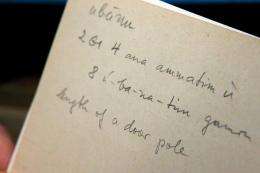Huge dictionary project completed after 90 years

An ambitious project to identify, explain and provide citations for the words written in cuneiform on clay tablets and carved in stone by Babylonians, Assyrians and others in Mesopotamia between 2500 B.C. and A.D. 100 has been completed after 90 years of labor, the University of Chicago announced June 5.
“I feel proud and privileged to have brought this project home,” said Martha Roth, editor-in-charge of the dictionary and dean of Humanities Division at the University of Chicago, who has been working on the project since 1979. “I feel this will be a foundation for how to do more dictionary projects in the future.”
“The Chicago Assyrian Dictionary is one of the most important and unique contributions of the Oriental Institute to understanding the civilizations of the ancient Near East,” said Gil Stein, director of the Oriental Institute. “The Assyrian Dictionary is the single most impressive effort I know of to systematically record, codify and make accessible the Akkadian language that forms the heart of the textual record of civilization in the place of its birth: Mesopotamia.
“The Assyrian Dictionary is not simply a word list. By detailing the history and range of uses of each word, this unique dictionary is in essence a cultural encyclopedia of Mesopotamian history, society, literature, law and religion and is an indispensable research tool for any scholar anywhere who seeks to explore the written record of Mesopotamian civilization,” he added.
The Chicago Assyrian Dictionary project was started in 1921 by James Henry Breasted, founder of the Oriental Institute and one of the country’s premier Middle Eastern archaeologists.
Although originally named after the Assyrian language, scholars found that Assyrian was a dialect of another Semitic language, Akkadian. Over the years, researchers filled out millions of index cards with references to the use of 28,000 words. The entries for each word denote various meanings and reference the contexts and ways in which it was used.
In the final volume, for instance, the listing for the word umu, meaning “day,” covers 17 pages and documents its use, for example, in the Epic of Gilgamesh: “Those who took crowns who had rule of the land in the days of yore.”
Robert Biggs, professor emeritus at the Oriental Institute, worked on the dictionary and also as an archaeologist on digs where he recovered tablets.
“You’d brush away the dirt, and then there would emerge a letter from someone who might be talking about a new child in the family, or another tablet that might be about a loan until harvest time,” he said. “You’d realize that this was a culture not just of kings and queens, but also of real people, much like ourselves, with similar concerns for safety, food and shelter for themselves and their families.
“They wrote these tablets thousands of years ago, never meaning for them to be read so much later, but they speak to us in a way that makes their experiences come alive,” Biggs said.
More information: oi.uchicago.edu/research/projects/cad/
Provided by University of Chicago



















